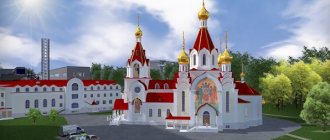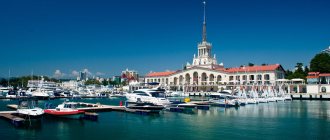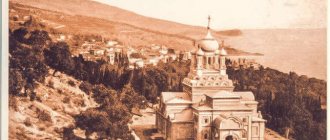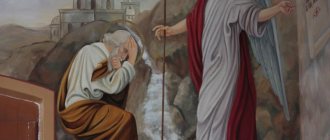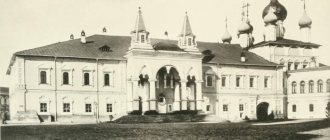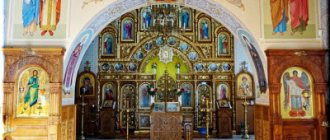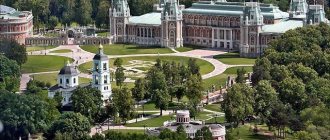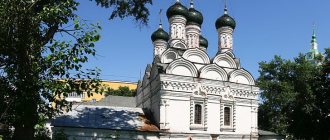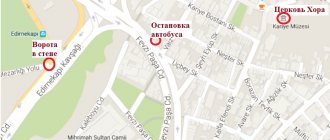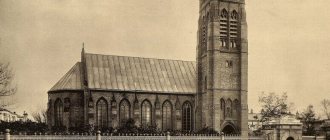Church of the Archangel Michael at the Clinics on the Maiden Field . In the 19th century, not far from the Novodevichy Convent, in the center of Moscow, the so-called. “Clinical Town” is a complex of medical institutions. The initiator of the construction was the medical faculty of the country's main university - Moscow University.
The end to the creation of the complex was reached only when a temple in honor of the Archangel Michael, consecrated in 1897, arose nearby. The construction work was led by architect Alexander Meisner. This year is considered to be the year of completion of the construction of the Clinical Campus.
The Church of the Archangel Michael at the clinics on Devichye Pole has become an integral part of the life of the medical town. Doctors, students, patients - these are the main parishioners of the temple.
However, it still cannot be called a narrow parish. Residents of neighboring streets, having all heard about the temple (and there were many of them), began to actively visit the shrine.
Church of the Holy Archangel Michael at the clinics on Devichye Pole
| Church of the Holy Archangel Michael at the clinics on Devichye Pole. Photo by Oleg Gusarov |
On November 8/21, the Holy Church holds a celebration in honor of the Council of the Archangel Michael of God and other disembodied Heavenly powers.
On this day, the patronal holiday is also celebrated by one of the Moscow churches that recently returned to life - in the name of the Holy Archangel Michael, which is located at the clinics on Devichye Pole Devichye Pole
The area beloved by Muscovites under the name Devichye Pole has been known since ancient times. Legend has it that even during the time of the Horde yoke, the servants of the Tatar khan drove the most beautiful girls of Moscow here and chose from them concubines for the khan in payment of tribute - this is where this name supposedly came from.
The reliable history of the Maiden Field begins from those distant times when here in 1456 the icon of the Mother of God “Hodegetria” was escorted to Smolensk, which in 1398 was brought to the Annunciation Cathedral of the Kremlin, and now, at the request of the Smolensk people, was returning back. In honor of the Smolensk icon, the Novodevichy Convent was later founded. It was he, as Moscow experts believe, who gave the name to the adjacent area – Maiden’s Field.
Another legend says that the first abbess of the monastery, Schema-nun Elena, had the nickname Devochkina, and this was imprinted in the name of the monastery. But most likely, the name of the monastery is due to the fact that it was intended for girls. (“New” monastery was called in contrast to the Old Maiden’s, which was probably considered the Ascension Monastery in the Kremlin or the Conception Monastery on Ostozhenka.)
In the 17th century, there was a great pilgrimage road along which pilgrims led by the Tsar walked from the Kremlin to the Novodevichy Convent, to the Most Pure Mother of God, which is why part of this road in the center of Moscow received the name Prechistenka. Then she walked along the Devichye Pole. And the temple of the Holy Archangel Michael, although it appeared much later, turned out to be standing on this holy road of Moscow.
In the 17th century, the “medical history” of this Moscow region began: then the gardens and vegetable gardens of the Pharmacy Order were established here, in which medicinal herbs were grown, which formed the basis of previous medicine. At the very end of the 17th century, the courtyard of Tsarina Evdokia Lopukhina, the first wife of Peter I, was located on the Maiden Field, and the local streets began to be called Bolshaya and Malaya Tsaritsynsky (now Bolshaya and Malaya Pirogovsky streets).
The spacious Maiden's Field, freely spread between the Novodevichy Convent and Zemlyanoy Gorod, for a long time remained a free territory, as if intended for folk celebrations and festivities. The largest celebration was organized in September 1826 in honor of the coronation of Emperor Nicholas I. Pushkin, who had just returned from Mikhailovsky, also took part in it. A separate rotunda pavilion was built for the august guests, and festive fountains flowed with tight streams of white and red wine for public entertainment. The people enjoyed themselves so much that it was decided to close down the festivities on the Devichye Pole. The emperor, who honored the festivities with his visit, looked after this territory for military exercises and reviews. Folk festivals returned to Devichye Pole only in the post-reform era, when the famous Novinsky festivities for Maslenitsa, Christmas and Easter were transferred here. They were held here until 1911, then they were transferred to Presnya, and a park was set up at Devichka. (By the way, this was done at the insistence of the doctors of the university clinics built nearby in the second half of the 19th century, since the festivities with their noise and dust disturbed the patients.)
The settlement of Devichye Pole began at the end of the 18th century. The estates of the Apraksins, Trubetskoys, Dolgorukys, Olsufievs appeared here: then those who, due to their duty at court, could not leave the city for the summer, settled here. They acquired country estates near the Kremlin, in places such as Devichye Pole. Later it became a kind of dacha settlement, where there were courtyards of the nobility, estates of the intelligentsia, and just houses with rented apartments in the fresh air. The historian M.P. Pogodin and the writer I.I. Lazhechnikov lived here.
However, the history of Devichye Pole ended only at the end of the 19th century, when the clinical campus of Moscow University was built here, on a convenient outlying territory, but close to Moscow.
“Learn from the Russians!”
The founding of the clinical campus was caused by the long-standing need of the Faculty of Medicine to have its own clinical base. It is interesting that Moscow University began its history with medicine, occupying the former building of the Main Pharmacy at the Resurrection Gate on Red Square: in 1758, a medical faculty was opened here with the purpose of “educating Russian doctors, operators, doctors and pharmacists.” This business required its own clinics, where it would be possible to treat patients and develop scientific theoretical knowledge, but the university did not have such a base for a long time. Although the charter prescribed the establishment of clinical, surgical and obstetric institutes at the medical faculty, there were not enough funds for them, just as at first there were not enough students. It got to the point that one day the faculty had to cancel a scientific debate because only one student showed up and there was no one for him to debate with.
Only in 1797, the medical faculty was finally allocated one ward for 10 people in the Lefortovo military hospital - this was its first “clinical base”. And in 1805, its own university Clinical Institute with therapeutic, maternity and eye departments was opened on Bolshaya Nikitskaya (it died in a fire in 1812). It was within its walls that Professor M. Ya. Mudrov formulated the famous medical postulates: that one should “treat not the disease, but the patient” and “it is easier to prevent a disease than to treat it.” At the same time, another, now forgotten, principle was revived: “The path to the sickbed of a nobleman lies through the human huts of his servants and through the huts of the poor.” This principle, together with a compassionate attitude towards the sick, became fundamental for doctors and students of Moscow University. It is no coincidence that one of the faculty clinics in the first half of the 19th century was the Novo-Ekaterininskaya People's Hospital, where medical student A.P. Chekhov completed his medical practice. In 1845, a clinic appeared on Rozhdestvenka, where already on February 7, 1847, for the first time in Russia, Professor F.I. Inozemtsev performed an operation under anesthesia. And yet, it was impossible under these conditions to carry out full-fledged medical practice with theoretical research, and simply help everyone in need. So an entire clinical campus was conceived for the medical faculty, which by that time had become not only the most popular of the faculties (more than a third of all university students studied there), but also the most in demand - half of Russian doctors received their education here.
Another reason for the creation of the clinical town was the urgent need of Muscovites for additional clinics and quality treatment. Therefore, charity became the second powerful force that ensured the creation of clinics on Devichye Pole. After all, neither the Moscow rich nor their households were insured against diseases. The history of the town shows the important role that private benefactors played in the creation of these clinics. Without their financial assistance, even the semblance of such a unique medical complex of a wide profile as was created at Devichye Pole would not have been possible. Philanthropists bought local land for clinics, donated capital for their equipment and maintenance, and provided benefits for poor patients. Typically, these clinics were named after donors, although some chose to remain anonymous. They insisted that the buildings be designed by the best Moscow architects: K. M. Bykovsky, R. I. Klein, I. P. Zalessky. Wealthy doctors also invested in the improvement of clinics. Thus, the hospital church of St. Michael the Archangel was built with a personal donation from one of these wonderful doctors. But more on this below.
The very idea of creating a town appeared in 1873, when the chief physician of the Novo-Ekaterininskaya Hospital, Professor I.N. Novatsky, turned to the city authorities with a request to move the university clinics to a new location using funds raised from the sale of the clinic site on Rozhdestvenka. Then nothing came of this plan, but it was taken into account. And in 1882, Varvara Morozova, a famous Moscow philanthropist, the creator of the Turgenev Reading Room and the Prechistensky Work Courses, the mother of the famous brother-collectors, decided to donate funds for the establishment of a psychiatric clinic for the university, according to the will of her late husband - Moscow really needed such a hospital. At the same time, the project to create new clinics in a new location resurfaced.
The initiator of the construction of an entire clinical campus on Devichye Pole is considered to be the famous surgeon N.V. Sklifosovsky, who was the dean of the Faculty of Medicine. This proposal was approached to the City Duma, and in 1884 it allocated the university a large plot of land on Devichye Pole and capital of more than 2 million rubles free of charge. The rest was contributed by philanthropists, the most prominent Moscow philanthropists. On the right side of Bolshaya Pirogovka there began to be located mainly university government clinics, built with the help of philanthropists, and on the left side there were private clinics, built entirely at the expense of benefactors and donated to the university, such as Khludovskaya, Morozovsky, Shelaputinsky.
The general foundation of the town took place in September 1887. It was designed and built by the venerable architect K. M. Bykovsky, who had previously studied Western experience in setting up such clinics. However, since there were no restrictions on funds, the Moscow clinics he built were superior to European ones, because they took into account all the needs of the medical process and the tasks of simultaneously training doctors in practice. Maximum comfort was provided to patients; The huge windows of the spacious rooms, traditionally for good hospitals, face south; there is a lot of sun and air in the rooms.
The first to open was the same psychiatric clinic of Varvara Morozova, from which the creation of the town began. The philanthropist bought a large plot of land in the Olsufievsky Lane area and in 1886 donated it, along with the built clinic, to the university. And in 1890, a neurological clinic building appeared nearby: it was the first university clinic built with treasury funds. (The Morozovs were later noted for the creation of the largest oncology clinic). The second, in 1889, opened a clinic for obstetrics and women's diseases, established on the initiative of the famous doctor V.F. Snegirev and the future temple builder Professor A.M. Makeev with a donation from E.V. Paskhalova (daughter of the manufacturer V.V. Nosov) and T.S. Morozov, father of Savva Morozov. It was near this clinic that a hospital temple soon appeared.
Each clinic in Devichye Pole has its own history, sometimes quite revealing. For example, a clinic for children’s diseases was created at the expense of Varvara Morozova’s brother, Mikhail Khludov, who served as A. N. Ostrovsky’s prototype for the image of Khlynov in the comedy “Warm Heart.” Khludov donated funds to set up a children's hospital after his 12-year-old son died in an accident: he fell from the stairs and died from a traumatic brain injury. The clinic for ear, nose and throat diseases was also unique for that time. Otolaryngology was not perceived as a separate science for a long time; diseases of the ear, nose, and nose were not included in the training curriculum for doctors, until the wife of an Irkutsk gold miner, Yulia Bazanova, had a niece with a sore throat. The necessary help was not found, the owner of large capital experienced the difficulties that doctors usually encountered when treating ENT diseases. She donated a million - and in 1896, in the area of Olsufyevsky Lane (in Soviet times, Rossolimo Street, in honor of Chekhov’s fellow student), the first ENT clinic in Russia was opened, which before the revolution bore the name of the founder.
The last to be opened in January 1896 was the university clinic, created at the expense of Varvara Alekseeva by the architect I. Zalessky and which became the architectural center of the clinical campus. Every Muscovite could turn to it for help. Now here is the rector's office of the Medical Academy named after. Sechenov, created on the basis of the former medical faculty.
The clinical campus was recognized as the best in Europe. In August 1897, at the XII World Congress of Doctors in Moscow, held at the Bolshoi Theater, N.V. Sklifosovsky declared that Russian scientists were no longer students, but full citizens of Europe. It was then that the German doctor Rudolf Virchow exclaimed: “Learn from the Russians!” Congress members visited the clinical campus. 1897 was the year of completion of the complex, which was celebrated with the construction of a monument to Pirogov (sculptor V.O. Sherwood did not live a few days before its opening) and the consecration of the hospital church in the name of the Archangel Michael.
And shortly before that, in the spring of the same year, here, in the therapeutic clinic of Dr. A. A. Ostroumov, one of the most famous patients of the town, A. P. Chekhov, was treated. He was brought here on March 25, the day after his throat started bleeding at a dinner at the Hermitage restaurant. The illness naturally brought thoughts of death, and the absence of a hospital church was acutely felt. Three days later, Leo Tolstoy, who lived in neighboring Khamovniki, came to Chekhov and began to console the patient with his teaching about immortality, which led him into a depressed state of mind - after all, Tolstoy did not recognize personal resurrection and an afterlife. He consoled Chekhov with the thought of merging with the “beginning of everything.” Chekhov was upset. “To me this principle or force appears in the form of a formless gelatinous mass, my “I” - my individuality, my consciousness will merge with this mass. I don’t need such immortality, I don’t understand it, and Lev Nikolaevich was surprised that I don’t understand,” Chekhov complained in one of his letters. On April 10, he was discharged for further treatment in Melikhovo, but the writer visited this place again, this time to say goodbye to him forever: in July 1904, the funeral procession with his coffin on the way to the Novodevichy cemetery made a stop near the monument to Pirogov, where a service was held lithium.
Back in the 1880s, the chapel of St. Demetrius of Prilutsky was built near the Pathoanatomical Institute. The location for the main hospital church, which appeared later, was chosen to be unique. And before moving on to the story about it, let us mention one more fact that testifies to the wonderful connection between the history of the Maiden Field and the hospital church. Not far from it, on Pogodinskaya Street, stands the house of the historian M.P. Pogodin - the famous Pogodinskaya Izba, unfortunately, instead of a museum, it is occupied by some institutions. Previously, there was the estate of Prince Shcherbatov, which ended up on the pages of “War and Peace”: according to the plot of the novel, Pierre Bezukhov visited this house. In 1835 the house passed to Pogodin. 40 years before the owner’s death, in 1875, almost all Russian writers and philosophers of the 19th century stayed there. Here, the leading Moscow intelligentsia celebrated the 700th anniversary of Moscow - it was the first anniversary of the city to be celebrated.
The main pages of the history of this house are connected with N.V. Gogol, who often lived here with a friend-owner, whom he met back in 1832, when he first arrived in Moscow. Here in 1841 he read the first volume of “Dead Souls”, here he wrote “Taras Bulba” and “Portrait”, here in the garden he celebrated the name day of St. Nicholas the Veshny. Until the last days of his life, he was a parishioner of the Church of St. Savva the Sanctified, which remained from that legendary Savvinsky Monastery, which, according to a vague legend, was founded by the noble Prince Alexander Nevsky himself (it stood in Bolshoi Savvinsky Lane, adjacent to Pogodinskaya Street). On February 7, 1852, the deeply ill Gogol confessed and took communion in this church, crying and staggering from weakness. A few days later he died in an apartment on Nikitsky Boulevard, and the last “Gogol” temple was the Church of Simeon the Stylite on Povarskaya. The Church of St. Savva the Sanctified, which preserves the memory of Gogol, at the end of the 19th century found itself connected with the fate of the hospital church of the Archangel Michael. History, thought, life and death, heroism and suffering, illness, sorrow and healing, faith and science - everything is intertwined with invisible threads in the vastness of the Maiden Field.
Alley of Life
The clinical town needed its own temple: the chapel could not provide for the spiritual needs of all its inhabitants. In the early 1890s, the head of the department of obstetrics, Professor Alexander Matveevich Makeev, decided to use his own funds to build the main hospital church in the name of Archangel Michael, the heavenly patron of his brother. This doctor remained in the memory of his contemporaries as a deeply religious man. In October 1893, he submitted a request to accept a donation in the amount of 100,000 rubles for the construction of the temple, and then financed its arrangement and decoration with silver lamps, bronze candlesticks and liturgical utensils. To carry out his plan, he invited M.I. Nikiforov, a not particularly well-known but reliable architect who had just successfully completed the construction of an obstetric clinic. The petition and the project drawn up by the architect received the personal approval of Emperor Alexander III. Already during construction, another donation was received for the temple, according to the will of an employee of the obstetric clinic E.V. Solovyova.
The territory for the temple was allocated, free from development, but at the same time such that it took a dominant position in the town. On July 17, 1894, its ceremonial laying took place, in which the clergy of the Church of St. Sava the Sanctified, where the sick Gogol prayed before his death, took part - then this church was closest to the newly founded hospital church. Three years later, the clergy of the Savvinskaya Church consecrated the bells of the new temple. It was designed for 650 worshipers and was built “following the example of ancient churches,” in the traditions of Moscow tent-roof architecture of the 17th century. It is believed that its prototypes were the Church of the Transfiguration, destroyed by the Bolsheviks, in Karetny Ryad, and the Church of the Nativity of the Virgin Mary in Putinki, on Malaya Dmitrovka. According to recollections, it was painted modestly, but, nevertheless, now it amazes the worshiper with its decoration and beauty.
In August 1897, before the consecration of the temple, K. M. Bykovsky, the chief architect of the Clinical Town, personally examined it, and was very pleased. Already on November 2, the temple was consecrated by His Grace Tikhon, Bishop of Mozhaisk. Concelebrating with him was priest Pyotr Pomerantsev, appointed rector, and, notably, the rector of the house university church of the Holy Martyr Tatiana, Archpriest N. Eleonsky. During the consecration of the temple, the choir of the Chudov Monastery sang. The celebration was attended by the rector of Moscow University P. A. Nekrasov, deans of faculties Professor V. F. Snegirev and Professor N. V. Bugaev (father of the writer Andrei Bely). All this clearly demonstrated the honorable involvement of the new temple with Moscow University. Moreover, the hospital church was taken over by the university and, along with the house church of the holy martyr Tatiana, became the second university church, which was already considered one of the best in Moscow.
After the end of the liturgy, the rector informed those present that the sovereign expressed his highest gratitude to Professor Makeev for the donation for the construction of the church, after which many years were proclaimed to the temple builder. In response, thanking everyone and the architect, Professor Makeev said that this temple serves as an expression of his possible gratitude to the Lord God and Moscow University, where he and his brother studied and to which they devoted all the best energies of their lives. “The church built in the name of the Holy Archangel Michael testifies to the sincere friendship that existed between us, brothers, and I decided to imprint this friendship on earth with the construction of a holy temple. Let me add my heartfelt wish: let the eyes of our student youth be turned not to one temple of science, but also to another temple, which enlightens the whole meaning of human life,” said Professor Makeev, ending his speech.
In 1911, two more chapels were built in the temple - the southern one, consecrated in the name of the holy noble prince Alexander Nevsky, the heavenly patron of Professor Makeev himself, and the northern one - in the name of the holy Great Martyr Catherine, in memory of his recently deceased sister. One can understand how warm the family feelings were in this family.
The consecration of the church officially completed the construction of the clinical campus. It became the house church for all the clinics on Devichye Pole, and its parishioners included doctors, service personnel, patients and students. However, the temple did not turn into a narrow parish church, like the house church of the Holy Martyr Tatiana - its official parishioners were also residents of the adjacent streets. They especially prayed for all philanthropists and organizers of local clinics.
The design of the temple's location is amazing. It stands at the beginning of the internal alley of the clinical town (lined on both sides with medical institutions) near the obstetric clinic, where babies were born into the world, who were often baptized in this church. Here a new life began - physical and spiritual. And the alley ended with the same chapel of St. Demetrius of Prilutsky, where the dead were buried in clinics: the chapel stood near the Pathoanatomical Institute, which the alley abuts. That is why this long, narrow alley was called the “alley of life”: it symbolized the life path of a person from his birth into the world to death, which began and ended with an Orthodox church.
In 1903, the chapel was piously furnished as a special temple for funeral services. This was done on the initiative of a local homeowner, merchant-philanthropist Dmitry Petrovich Storozhev. The Monk Demetrius of Prilutsky was his heavenly patron. In March 1902, Dmitry Storozhev submitted a petition for permission to rebuild the chapel into a church at his own expense, so that the poor relatives of those who died in university clinics could freely, without additional or specific payment, perform their Christian funeral after the liturgy.
However, such construction required permission from the Holy Synod, and while it was being received, the merchant died without seeing his brainchild. His nephew, who also lived on Devichye Pole, undertook to carry out the will of the deceased. By September 1903, the architect B.N. Kozhevnikov expanded the chapel to the size of a temple and added an altar to the east. It is significant that the consecration of the new church in the name of St. Demetrius of Prilutsk took place on the day of memory of St. Sergius of Radonezh, whom St. Demetrius especially revered. More than once he came to St. Sergius’s monastery for prayer and spiritual guidance. With the construction of this “funeral” temple, the avenue of life took on a complete form: two temples marked the beginning and end of human life.
The pre-revolutionary history of the Church of the Archangel Michael turned out to be short, but bright and strong. The temple was in demand by the sick and suffering, especially at a time when society was already losing its spiritual guidelines and moving further and further away from the Church. Over the short years of the temple’s existence, its spiritual appearance and its Moscow tradition have developed, which, fortunately, has continued to this day.
In 1913, the church clergyman was awarded commemorative medals in honor of the 300th anniversary of the Romanov dynasty. And during the First World War, when the clinical town was turned into a hospital, the priests of the church cared for many wounded soldiers who were being treated here. In 1916, for this spiritual consolation of the defenders of the Fatherland, the rector of the temple, Father Pavel Vinogradov, was awarded the right to wear skufiya. And then the revolution broke out.
“Our temple was lost, but the Lord revived it”
Revolutionary upheavals also reached the clinical campus. By the February decree of 1918, the Church was separated from the state, all home churches were abolished. The Church of St. Archangel Michael became an ordinary parish church, and its property was declared “national property” and described. In 1922, the property of the temple was confiscated, including more than 1 pound of precious liturgical objects and even the shroud. And he soon lost his relationship with the university: in 1930, the medical faculty was removed from Moscow State University and transformed into the First Medical Institute, later named after I.M. Sechenov (now the Moscow Medical Academy named after I.M. Sechenov).
And already in 1931, despite the requests of local residents, the temple was closed, since the neighboring workers’ club laid claim to its building (the Church of Saint Sava the Sanctified also died in the same year). The parish community of the church was denied registration. The official reason for the refusal was purely Soviet: an existing temple cannot be located next to cultural, educational and public institutions (probably referring to the First Medical Institute and local clinics). The temple building was used as a “cultural and educational reading room”, then as a gym, a pharmacy, a warehouse and an institute museum. For this purpose, the building was rebuilt accordingly to give it the proper appearance without a hint of a “cult” affiliation. Already in the 1930s, its light, beautiful tent domes and bell tower, as if molded from snow, were demolished, windows were broken in the walls, partitions were erected inside and the decoration was destroyed.
But even this was not enough for the authorities. The institute administration, despite the recommendation to include the temple building in the list of monuments of Moscow architecture, began to seek its complete demolition in order to erect a catering building on this site. In 1977, demolition had already begun, the altar apse and the northern Catherine's chapel were dismantled, but then the original architecture of the building was revealed, and the destruction of the temple was stopped by incredible efforts of the public.
And in the early 1990s, church life returned to the temple: on the initiative of the rector of the Medical Academy M.A. Paltsev, both buildings of the former clinical churches were transferred to the Russian Orthodox Church. Restoration work began in the temple. The temple was also helped by the solemn anniversary - the 100th anniversary of the clinical campus, celebrated in the fall of 1997, when it was visited by government members. It was then that His Holiness Patriarch Alexy II performed the minor consecration of the restored church and presented the parish with an icon of the Mother of God.
The great consecration of the temple took place on September 19, 2002, on the day when the Holy Church remembers the miracle of the holy Archangel Michael in Khoneh. The consecration was performed by His Holiness Patriarch of Moscow and All Rus' Alexy II. At the end of the liturgy, the rector of the temple, priest Andrei Shumilov, addressed His Holiness the Patriarch with a welcoming speech and presented him with a panagia, which depicts the Lord returning the lost sheep - in commemoration of the dramatic fate of the revived temple: “Our temple was lost, but the Lord revived it.” In response, His Holiness the Patriarch presented the parish with an image of the Savior as a blessing.
Now the restored temple already from afar pleases the soul and eye of the pilgrim. For those who cross its threshold, it is as if a heavenly world opens up. The light airiness of the temple is associated with its dedication to the archangel. The dome is painted in tones of heavenly azure, combined with snow-white clouds. In the vault of the dome there is an image of the God of Hosts with the Holy Spirit in the form of a dove, and below, in the belt of the dome, snow-white archangels are depicted soaring in the blue ether. Closer to the ground, the heavenly tones of the painting turn into milky pink, creating indescribable beauty.
The main iconostasis is low and narrow: the temple icon of the Archangel Michael, hung with crosses, is located in a luxurious carved icon case to the right of the choir. This icon was brought here from the Church of St. Nicholas the Wonderworker in Khamovniki as a gift for consecration. There are many rare icons here. For example, there is an image of the Mother of God “Helper in childbirth”, there is a revered “Healer” and an icon of the Great Martyr Catherine, also revered as an assistant in childbirth and patroness of children. Particles of the relics of the great martyrs Panteleimon and Theodore Tiron are kept here.
The temple has fully retained its home character, caring for patients of local clinics, doctors and students, although it remains a parish for everyone. The “alley of life” has now been restored to its original design. The path along it evokes thoughts about the sorrows and illnesses that accompany our life, and about death, which inevitably ends it, but it consoles us with the knowledge that it will end in the temple, just as it began.
A beautiful Moscow temple built in memory of his brother
During the consecration of the temple, Professor Makeev made a speech: “The church built in the name of the Holy Archangel Michael testifies to the sincere friendship that existed between us, brothers, and I decided to imprint this friendship on earth with the construction of the holy temple. Let me add my heartfelt wish: may the eyes of our student youth be turned not to one temple of science, but also to another temple, which enlightens the whole meaning of human life.”
In 1911, two more chapels were built in the temple - the southern one, consecrated in the name of the holy noble prince Alexander Nevsky, the heavenly patron of Professor Makeev himself, and the northern one - in the name of the holy Great Martyr Catherine, in memory of his recently deceased sister.
It is interesting that the design of the temple was prepared by one architect, and the temple was built by another architect.
The project was prepared by Mikhail Illarionovich Nikiforov (1837 - after 1897), he has many civil buildings to his credit, but the church, as far as is known, was the only one in his portfolio. Simultaneously with the temple, in 1894–1897, an obstetric clinic was built according to his design on Devichye Pole, which was directed by Makeev.
Alexander Felitsianovich Meisner (1859–1935) supervised the construction of the temple.
The temple became home to the entire complex of the clinical campus, and newborns born in the obstetric clinic were baptized here. Makeev did a lot to sharply reduce the mortality rate during childbirth.
It came down to anecdotal cases. One day, an attendant of the anatomical theater complained to the professor that “there are few deceased women from the obstetric clinic, and there is no income at all.”
In 1918, the church was separated from the state and the church became a parish church; then everything went according to the established pattern for most churches in the country at that time.
First, a club was built next to the temple in 1927–1929. In 1931, the temple was closed due to the fact that churches, by law, should not be located next to cultural and educational institutions. Complete absurdity!
The hipped domes and bell tower were destroyed, windows were broken in the walls, partitions were erected inside and the decoration was destroyed. A new life began - there was a reading room, a gym, a pharmacy, a warehouse, and a museum.
For a long time I believed that most churches were demolished and destroyed before the Great Patriotic War, but, alas, this was not the case. A lot of churches were destroyed after the Great Patriotic War, especially during the reign of Nikita Sergeevich Khrushchev.
But the Church of the Archangel Michael during the time of Khrushchev was only rebuilt in 1961, although then it was almost destroyed completely in 1976; only a third of the temple was destroyed, despite the fact that in 1974 the building was included in the list of architectural monuments. But the leadership of the First Moscow State Medical Institute wanted to build a catering unit instead of a temple, because you always want to eat, especially for students.
If it were not for the transfer of the temple to the church in 1992, then perhaps it would have gradually collapsed completely. But as a result, by 2002 the temple was gradually restored.
The temple was also helped by the solemn anniversary - the centenary of the clinical town, celebrated in the fall of 1997, when it was visited by members of the Russian Government. It was then that His Holiness Patriarch Alexy II performed the minor consecration of the restored temple. The great consecration of the temple took place on September 19, 2002, also by His Holiness Patriarch Alexy II. And we can now admire the beauty of the temple.
Mysterious temple on the hillside
Hello, dear friends!
Continuing the story about the expedition to the Krasivaya Mecha, which took place in August 2021, I want to tell you about the Church of the Archangel Michael in Maslovo, which is on the Krasivaya Mecha River. And this is not a reservation. This temple is also called the Church of the Archangel Michael.
Previous stories about the expedition: “Temple made of used bricks”, “Valley of megaliths, or Russian stone henge”, “Stone road to nowhere”, “An ancient city of which not even the name has survived.”
We take official information about this temple from the website of the State Public Historical Library, from the already familiar book “Parishes and Churches of the Tula Diocese: Extracts from Parish Chronicles.” - Tula, 1895. Link here.
And so, we read a brief official historical summary:
The village of Maslovo on the Mechi River is located 120 versts from the city of Tula and 25 versts from the district Efremov. The parish, in addition to the village of Maslova on Mechi, includes the following villages: Vedmino, Kochergina, Malaya Kosaya, Staraya Kosaya, Vytemki-Pestovo and Kostomarov Khutor with a population of 1253 male peasants and 1306 females.
The history of the initial formation of the parish. Maslova on Swords, and the time of its foundation, due to the lack of church chronicles, are unknown.
Initially, the village had a wooden church in a place called a graveyard, on the right side of the Mechi River (now there is a forest there).
The current stone church stands on the left bank of the same river, built in 1805 at the expense of parishioners in the name of the Archangel Michael, with a side altar in the name of the holy martyrs Boris and Gleb. The iconostases in the present church and in the side altar were replaced with new ones, the first in 1883, and the last in 1892, both of them were built at the expense of the parishioners.
For a long time, there have been three zemstvo schools in the parish: the first at the church of the village. Maslova, the second in the village of Vedminaya and the third in the village of Staraya Kosoy.
End of official historical information.
The only thing that remains to be added to the quote from the book is that in Soviet times, they tried to blow up the temple three times, but the structure survived, and at the moment we see what is usually hidden from view - the internal structure of the walls.
I have already talked about what the mentioned book is in the article “The Impossible Temple of the Archangel Michael.” Reading the description of today's temple in it, we see very interesting points.
Firstly, the time when the parish was founded is again unknown. Well, in ancient times there were no statistical records, and apparently no one sent donations from parishes to higher church administrations, until in the 19th century they realized it and decided to count and record all the parishes.
Secondly, the location of the wooden temple on the other side of the river. At a time when all the villages of the parish are located on the left bank, according to the mentioned book, the wooden parish, if there was one, was located, for some reason, on the right. Official data says nothing about the presence of a bridge across the river. Now there is a forest on the right bank, and it is not possible to confirm or deny the presence of a wooden church there. By the way, in this forest there are megalithic structures similar to those we examined in the article “Valley of Megaliths, or Russian Stone Henge.” Another expedition is planned to these megalithic structures in the forest in the summer of 2021.
Thirdly, the replacement of iconostases with new ones, as we see, occurs at the end of the 19th century. I would not be surprised if before the indicated dates there were no iconostases at all, and in the indicated years they were simply made for the first time.
And one more interesting point in the official documentation. If you look at information about the temple on the website cathedrals ru, then pay attention to what is the source of official information: metric books about those born in 1840−1850, about those who died in 1841−1842. and marriage search for 1824−1834.
Don't you find it strange that birth and death records of people are used as a source of official information about the temple? It’s the same as in our time, in the registry office, looking for the date of road repair. And why was this particular period of metrical records chosen, if according to the official data of the same website cathedrals ru, the church was supposedly “built” in 1805. Friends, do you know what it looks like? To the generation gap. When the eyewitnesses of the so-called “construction” of the temple had already died, and the emerging generation accepted reality as they were told, and as we are being told now.
But these are not all the oddities associated with this temple. The strangest thing is his position at the moment. It is not just located on the left bank, the temple is located on the slope of a hill, contrary to all logic, because a temple located on a hill can be seen further, it would be visible from all the villages belonging to its parish, and the ringing of bells would also spread further.
Just wondering what logic the builders followed when choosing a place for the temple? Moreover, it is known that laying a foundation on a slope is much more difficult and costly than on a relatively flat surface.
This is the slope the hill has. And if you climb this hill, you will find yourself above the dome and cross on the temple. Friends, don't you think this is strange?
The next incomprehensible moment.
The door hinges are inserted not into stone, but directly into brick, which in itself is strange, because there is more than enough stone here, and the valley of megaliths is very close. If there is a natural outcrop of natural stone, as some tried to convince me, then why not use these stones to attach the hinges? After all, installing door hinges of this size implies a massive and heavy door. In previous articles on temple buildings, we have repeatedly seen such hinges, and they were always installed in stone, even where there was no natural stone nearby, it was found and brought, or, in extreme cases, cast on the spot. So why didn’t they use this opportunity here? Maybe the reason is that the stones of the megalith valley are not natural, but at that time it was also some kind of structure?
From the inside there are strange arched openings that are much lower than the windows. It is possible that these are just niches, or perhaps something else.
The dimensions of the bricks from which the temple is built are close to modern standards.
The altar of the temple is directed to the northeast, that is, it is oriented towards the so-called “old north pole”, and the deviation from the modern one is approximately 30 degrees. The radiation level is within the normal range of 14−16 μS/h.
Despite the fact that the building is currently a ruin, everything stands quite firmly, and this despite the fact that many of the walls below are thinned, and some of the ties are cut off. You can imagine with what safety margin the building was built!
However, I don’t recommend climbing there, because nothing lasts forever, and sooner or later, it will all fall and no helmet will save you.
There is no bell tower near the church. It is not clear whether she was in ball at all. It is quite possible that it was blown up during Soviet times. But it is clear that during construction, a gable roof was not planned.
This can be seen from the grooves on the wall. Moreover, it is clear that the roof was rebuilt at least twice. This can also be seen from the grooves. Friends, here I want to make a remark that in all the abandoned temples we visited, we never saw a gable roof installed during construction. I constantly talk about this in my articles. The buildings now called churches were not designed for use in conditions of high rainfall. You can watch films and articles yourself about our past trips to temples, or wait for articles about temple buildings that will be published in the future.
By the way, they also tried to blow up the horse-stone, which is located only 3.5 km from this temple, and which is also supposedly of natural origin. It looks a lot like stripping to hide something. It's too obvious a coincidence.
We continue the inspection. Now there is a cemetery around the church.
Burials on it continue to this day, despite the fact that the villages around are almost abandoned. In the recent past, this cemetery was much smaller.
Friends, I especially want to draw your attention to the huge amount of forged iron fittings. In some rows, for example above the arches, there are as many as two rows.
Although I said this in other articles, I will repeat it again. For a building operated in a gentle mode, such reinforcement is more than excessive. Both in terms of the number of ties and their thickness. Such reinforcement is necessary only if the building is located in a seismic zone or is subject to vibration from the inside. In addition, such excessive reinforcement leads to a huge waste of metal. If this were an isolated case, then this could be somehow explained, for example, by the generosity of patrons of the arts, or the lack of thinner strips of metal, but we see such reinforcement on all temple buildings, and not only temple ones. An article about the Demidov plant is currently being prepared, and it will be published soon. So there are the same screeds, and not just screeds. See for yourself, it will be interesting, don't miss it.
As for these ties, they wrote to me many times in the comments that these are ties for atmospheric electricity. Friends, I myself am a supporter of atmospheric electricity, especially since we can see its manifestations even now, in the form of lightning, during a thunderstorm. But do you know what is the easiest way to discredit any idea and cause skepticism and even disgust towards it? This is to bring it to the point of absurdity. With atmospheric electricity this is a clear example.
They constantly write to me that the screeds in the walls played the role of some kind of conductors, that even the walls were heated by them, and so on. Taking this opportunity, I would like to immediately clarify our vision of this issue. To generate atmospheric electricity, you need a so-called Tesla coil.
We never found it embedded in the wall. Moreover, for electricity, any kind, atmospheric, underground or otherwise, the most important condition is good contact between conductors. Namely, it is not in the screeds.
The ends of some ties are inserted into the hinges at the ends of others, providing mechanical tensile strength. Electrical contact, if there was one at the beginning, will disappear over time due to oxidation of the metal surface and due to the lime mortar with which these connections are covered. In modern electrical engineering, detachable connections are prohibited from being walled into the wall precisely for this reason. And such connections, if they exist, in modern technical language, are called serviceable, and are located in special junction boxes.
Here, all the “contacts” are walled up in the wall. The logical conclusion immediately arises that either it was built for 1 season, or the builders did not know electrical engineering. Both are incorrect, since we have already seen many times the masterpiece of the buildings of the past, that is, the builders were competent people who knew their job, and certainly for 1 season, they will not build such a structure at such costs. Therefore, the explanation for all this is the simplest - all these ties played a purely mechanical role - strengthening the load-bearing structures! For atmospheric electricity, the equipment had to be larger and more complex than just fittings in the walls, and this equipment was located inside buildings rather than in walls.
And we continue the inspection. The temple itself stands on a kind of elevation. This mound is fragments of walls, bricks and construction debris resulting from the destruction of the building.
But the debris alone is not enough to fill such a mound. There's probably something else down there! No one has ever carried out excavations here.
The reinforcement sticks out of the ground, which means the wall continues down, and the reinforcement most likely goes to the foundation. You can see for yourself what they knew how to build then: the building still stands, although by all modern standards the top should have collapsed long ago. We never saw the foundation itself; it is much deeper under the surface.
The vault of the dome is not round, it has 8 sides. Moreover, at the place where the vertical wall transitions into the vault of the dome, so-called “voice boxes” are installed, 8 pieces, one on each side.
I started the story about what “golosniki” are in an article about another church of the Archangel Michael, in the Plavsky district, so if you haven’t read that article, I recommend reading it first before writing in the comments that “golosniki” needed to improve acoustics.
And now, I would like to explain a little our point of view regarding voice speakers.
Before reading further, I suggest you watch two scientific films that explain the wave theory of sound. The first film “Physical Foundations of Acoustics”, produced by Tsentrnauchfilm, from 1980 (our topic starts at 8 minutes 35 seconds). The second is “How to turn white into black.” Explanation of the laws of incidence and reflection of waves, using light as an example.
And so, in the first film, we see something similar to voice boxes. This is called a Hemholtz chamber, but it needs to be clarified that, firstly, these vessels are not embedded in the wall and have a free outer surface, and secondly, the sound source is located behind these chambers. In our case with the temple, the pots are completely embedded in the wall, over the entire surface, with the neck inside the building, implying that the sound wave will enter through it. Let's see what happens in this case, using the example with light, in the second film, since light, in this particular case, is the same as waves.
And so, it is clearly seen that voice speakers cannot inherently improve the acoustics of buildings. On the contrary, they absorb sound, but I also agree with the comments that these voice boxes are not enough for noise absorption. And we leave the question open about what voice boxes actually are, and what they are needed for, friends, write your comments, we will decide together! And be sure to check out the additional material in the links above. And we explore the temple further.
On the dome there is a turret, the so-called “light drum”, connected to the main volume.
Friends, what do you think this turret is for? As for the dome, it was also written many times in the comments that if there is a dome, then it is for atmospheric electricity, otherwise it simply does not make sense. Guys, everything is actually much simpler. I’ll try to explain: if we have a round building (or one approaching round, for example, 8-sided), then putting a flat roof there, given that there is a decent height, is sometimes much more difficult and costly than making a dome. See for yourself.
To install a flat roof on a round building, you need floor beams. The larger the diameter of the structure, the thicker and longer these beams are. But the length of all beams must be different if builders want it to look beautiful from the outside. And as we know, they paid a lot of attention to this. So, all floor beams are of different lengths, in extreme cases, in pairs, no more. They need to be lifted to the top and secured. Then you need to arrange a ceiling on the beams, either from boards or concrete. Now there are many options, they probably existed then, but everything here comes down to expediency - delivery and lifting of material, calculation and marking work, etc., etc., but look how a dome is made by one person from the same brick .
How much faster, easier, and most importantly more reliable and stronger it is! After all, even an apprentice can lift bricks, one or two at a time, and no lifting devices are needed. I repeat once again, the builders of the past were masters of their craft, and they did everything beautifully and for centuries, only because they knew a rational approach to their work. As for the strength of arched and straight ceilings, see for yourself.
A straight ceiling works against fracture, and an arched ceiling works against material compression. As a conclusion, a dome on a temple building is the most practical and durable option for constructing a roof. But I got distracted, let’s return to our temple.
There are many large fragments of walls around it. Lime masonry is so strong that it holds the brick tightly.
That is, when falling apart, the walls do not fall apart into individual bricks, but fall out in pieces along the cracks that formed when they tried to blow up the church. Moreover, the brick is very old. In some places, erosion has destroyed the bricks, leaving the mortar virtually intact.
The walls were plastered from the inside. Elements of painting can still be seen on the plaster, but what is depicted there can no longer be made out.
What’s interesting is that even in this church, probably destroyed during Soviet times, we see traces of alterations. The window frame was clearly set in cement mortar.
It is not possible to determine the presence or absence of stoves and chimneys, as well as a thermal vestibule, since most of the structure was completely destroyed, and precisely on the western side, where, according to the canons, the entrance should be located.
And so, friends, we looked at what remains of the Church of the Archangel Michael, and now I want to ask you, how logical is it that this building, when it was originally built, was a temple? Friends, look at this photo of the blast furnace at the Kazhim plant.
Considering our temple in this way, many things become clear. For example, the location of the temple is closer to the water, and from the hill there is more convenient access to the flue pit. In this vein, the purpose of the turret on the dome and the “voices” under the arch also becomes clear. I am not saying that this temple was originally a blast furnace, it could have been the production of bricks, glass, lime or ceramics firing, even bread baking, or, finally, just a weaving factory, but the fact that this building had a technical purpose , and not a cult one - there is no doubt.
Friends, this was the fifth and final article from the report on the expedition to the Beautiful Sword. There are much more places examined and facts collected; a lot of material remains behind the scenes, but it will certainly be used in other films and articles, indicating where it was filmed. We did not have time to explore even more places, for example, pyramids, as well as entrances to basements or dungeons, and we are planning to go to Beautiful Sword again in the summer of 2021.
In conclusion of the story about the expedition, I would like to draw a general conclusion about all five films.
When I raise the issue of nuclear war in the 19th century, many people object to me that if at that time the level of scientific and technological progress was developed to the point of obtaining nuclear weapons and means of delivering them, then other industries should have also been developed, and they offer to show me plants and factories of the past, which, as many believe, do not exist, since they could not have existed in principle. However, we see that many ancient structures have a technical purpose, but they are purposefully disguised as religious ones.
All these places, namely the Ishutinskoye settlement, the stone road, the Church of the Nativity of the Virgin Mary in the village. Lavrovo, the valley of megaliths and the Church of St. Michael the Archangel in Maslovo, as well as all other places, all this is actually one place - the place of a huge tragedy.
Once upon a time there was a large city here, comparable in size to Tula, and all that remains of it are small monuments scattered around the area, and there are some people who ironically believe that some of these monuments are of natural origin.
Friends, our expedition has ended, but the end of our research has not yet been reached. There were several expeditions in the summer of 2021, so there will soon be a continuation of the story and development of the topic. If you don’t understand something or have doubts about something, ask questions in the comments. For every statement given in the article, we have facts and evidence, but it is important for us to know your opinion, as well as how clearly the material is presented. Therefore, do not hesitate to write, all comments are read, and every voice will be heard!
I don’t say goodbye to you for this. See you soon in the next articles!
Thank you for your attention, all the best to you. Goodbye!
Gallery
show all photos
Gallery
show all photos
